A cardinal and gold day at the Iowa Capitol
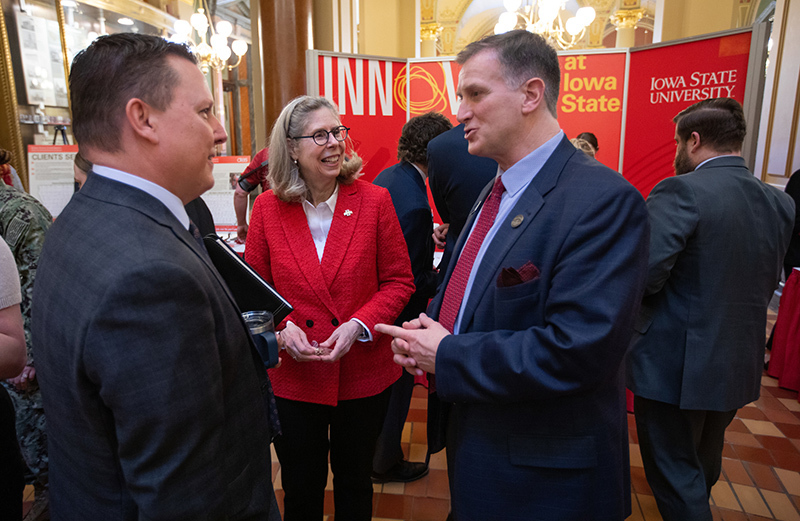
President Wendy Wintersteen visits with Reps. Dan Gehlbach (left) and Bill Gustoff during ISU Day at the Capitol Feb. 21. The two represent Dallas and Polk counties, respectively. Photo by Christopher Gannon.
Iowa State delivers $5 billion impact to state economy
An Iowa State University startup that developed a new technology to assist with the creation of new therapies for cancer and autoimmune diseases is just one example of how the university impacts the state's economy and benefits society as a whole.
The value of Iowa State's $5 billion economic impact for fiscal year 2021-22 is measured by its cutting-edge research, economic development support for business and industry, student and visitor spending, alumni earnings, campus operations and construction, and ISU Extension and Outreach. These activities support stronger, more resilient communities, according to an economic impact and investment analysis of Iowa State and the other regent institutions conducted for the state Board of Regents by the labor market analytics firm, Lightcast. A director from the firm will present highlights to the board at its April meeting.
Iowa State's total economic impact supports 57,142 jobs -- or one out of every 36 jobs in Iowa -- for fiscal year 2021-22, the timeframe reviewed for the analysis. Its economic impact in 2021-22 represented 2.4% of the state's gross state product -- an impact nearly as large as the entire utilities industry in the state, according to the study.
"Iowa State University supports dynamic economic growth and prosperity through our research, teaching and extension and outreach. We continually adjust our programs to align with the state's workforce demands and the needs of business and industry. By doing so, Iowa State maximizes the return on investment for our students and all Iowans," said President Wendy Wintersteen.
Return on investment
In addition to its economic impact, Iowa State provides a significant return on investment for students and taxpayers. Students earning a bachelor's degree leave Iowa State prepared to enter the workforce, serve as leaders in their communities and will earn $23,600 more each year than someone with a high school diploma working in Iowa.
Learn more
The Economic Value of Iowa State University of Science and Technology:
For taxpayers, the return on funding provided to Iowa State totaled more than $484 million from added tax revenue from students' higher lifetime earnings and increased business output. For every dollar of public money invested in ISU, taxpayers will receive $1.90 in return, over the course of students' working lives.
The following is an overview of key findings from the economic impact analysis and investment analysis. More detail is available in the Iowa State full report.
Alumni
The education and training Iowa State provides has the greatest impact on the state of Iowa. Today, tens of thousands of alumni employed in Iowa over their career had a net impact of $2.1 billion in added income, which is equivalent to supporting 23,391 jobs.
Research
SoyLei Innovations -- a green technology startup that developed a soybean oil-based alternative to petroleum-based asphalt -- is another example of the value of Iowa State research. University research spending and activities created a net total of $235.3 million in added income for the state economy, according to the analysis. The added income is equivalent to 3,822 jobs.
"Innovation and entrepreneurship are critical drivers of the state's economy," said vice president for research Peter Dorhout. "Our relentless commitment to creative discovery and invention in research is reflected in startup ventures like SoyLei Technologies. It is this same commitment that makes Iowa State a trusted partner in the development of innovative solutions for federal and state agencies, foundations, and private industry."
The office of innovation commercialization works closely with faculty to apply their research and bring it to the marketplace. Over the last four years, Iowa State received 645 invention disclosures, filed 182 new patent applications and produced 174 licenses.
Economic development
Iowa State-supported startup and spinoff companies added $1.7 billion in income to the state economy in fiscal year 2021-22. This impact, which is equivalent to supporting 11,178 jobs, includes the positive effect of ISU's Small Business Development Center and businesses assisted through the Center for Industrial Research and Service (CIRAS).
Extension and outreach
Iowa State's $5 billion impact:
- Supports 57,142 jobs, or one out of every 36 jobs
- Adds $1.7 billion to Iowa's economy from startup and spinoff companies
- Increases lifetime earnings by $1.1 million per graduate with a bachelor's degree
- Is approximately 2.4% of the state's total gross state product
Extension and outreach provided more than 800,000 direct educational contacts, which includes a food safety certification required by state law. In 2021, more than 2,000 food service supervisors participated in ServSafe classes delivered by ISU human sciences extension and outreach specialists, with 77% earning certification to help ensure food service workers have the knowledge they need to protect the public from foodborne illness.
For 2021-22, extension and outreach provided certification for:
- 2,756 companies
- 16,785 farmers
- 21,151 non-farm employees
While employee salaries were included in the analysis, it did not measure the economic impact of Extension and Outreach outcomes due to the specific nature of the majority of programs and services it provides. For example, 4-H is a statewide program that prepares students for STEM fields and leadership roles, but it is difficult to quantify an economic value. Still, the report noted that the private and public value of extension and outreach is significant.
Student benefit
An Iowa State education offers students hands-on learning in the classroom, undergraduate research experiences and countless leadership opportunities. Students earning a bachelor's degree can expect to make $23,600 more each year compared to someone with only a high school diploma in Iowa.
In return for their investment, a student earning a bachelor's degree in 2021-22 will see $1.1 million in higher earnings over the course of their working lifetime. The total present value for all fiscal year 2021-22 students during their working careers is $2.8 billion.
As detailed in the investment analysis, for every dollar Iowa State students invest in the form of out-of-pocket expenses and forgone time and money (while earning their degree), they will receive a cumulative value of $5.10 in higher future earnings. The students' investment has an average annual internal rate of return of 14.6%. The U.S. stock market's 30-year average rate of return of 10.5%.
Taxpayer and societal benefits
Not only do Iowa taxpayers benefit from greater tax revenues from students earning an Iowa State degree, but they also see significant cost savings in three categories: healthcare, justice system and income assistance. Combined, the present value of the benefits associated with an education from Iowa State is nearly $564 million in savings and added taxes for state and local taxpayers.
Through education, research and Extension and Outreach, Iowa State provides nearly $6 billion in benefits to society as a whole. This includes:
- $2.9 billion, added student income
- $1.6 billion, added business income
- $1.1 billion, added income from university activities
- $227.2 million, social savings (related to health, justice system and income assistance)
So long, coal
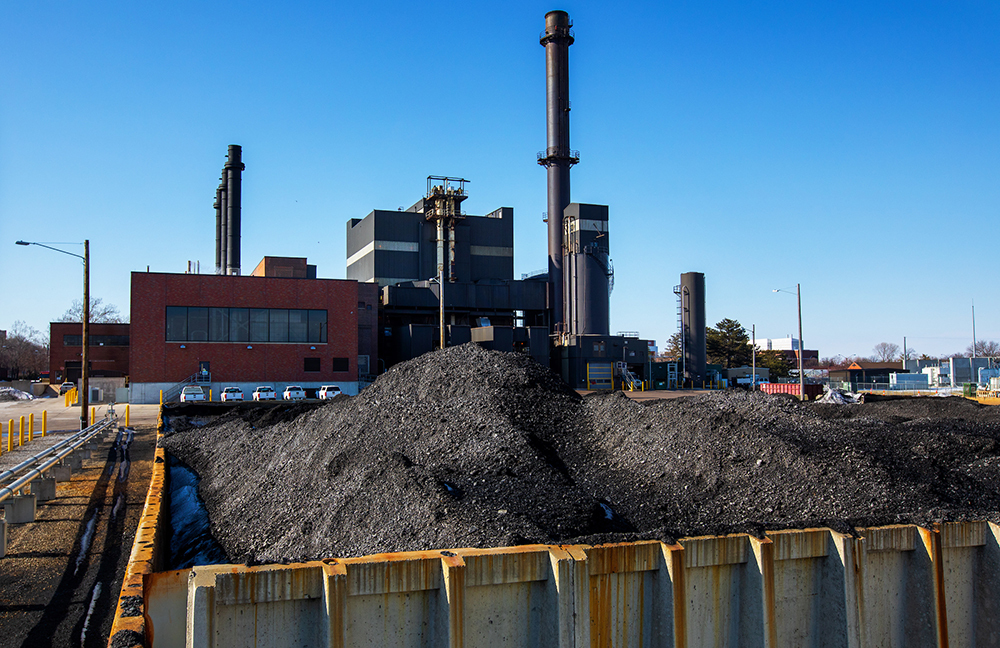
A small coal storage lot east of the power plant holds the final coal reservoir, photographed earlier this month. Photos by Christopher Gannon.
Psst. You likely won't hear it, the sound of the university's last coal-firing boiler chewing through its final load of coal and limestone. But later next week, after 155 years of burning coal, Iowa State will quietly bid farewell to the carbon-based fuel.
The final coal shipment arrived to campus the first week of February; how long it would last became a matter of weather and mechanical hiccups with the boiler -- cooler temps speed up consumption, hours or days out of service slow or stall it. Mike McCurdy's team got both. Similar to the breakfast cereal at the bottom of the box, the last coal was finer in texture, he said, and prone to clogging the conveyors and inlets that move it into position.
McCurdy, senior manager for utility operations, was tasked, each day for the last four weeks, with "getting one more day" out of the coal boiler. The boiler maintenance team will be as happy as any to be done with coal, he said.
How to celebrate such an historic week? McCurdy said some coal from the last bucket to enter the power plant will be set aside for mementos for utilities staff and others. What those look like hasn't been decided yet.
Natural gas fleet
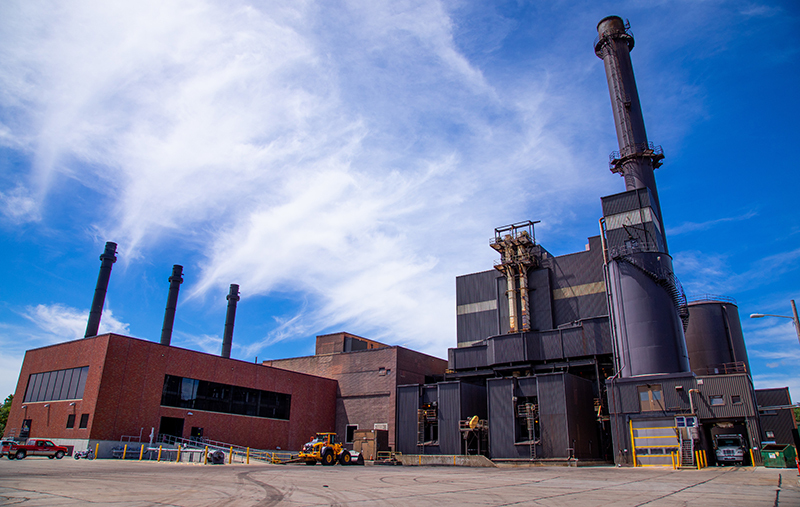
Coal- and ash-handling equipment on the east side of the power plant can be removed when the final coal-burning boiler is converted this summer to run on natural gas.
By late March, work will begin to convert the boiler to burn natural gas, joining the other four gas-powered boilers in the power plant on the northeast side of campus. Crews will duplicate the same process they followed last spring and summer, when they converted another coal-burning boiler to use natural gas. It went into use in October. The 36-year-old boiler duo probably has another 25-plus years of service left, said utilities director Mark Kruse.
Because Iowa State is ending its use of coal, more steps are part of this year's conversion, including removing coal and lime silos and conveyors, and working with a consultant and the state Department of Natural Resources to remediate two east campus lots that stored coal piles for decades.
The rewards
Kruse, who serves on the university's sustainability committee, said the end of coal as a campus energy source is good news on several fronts:
- The university meets another goal in its 2021-25 Strategic Plan for Sustainability in Operations: a 35% reduction in emissions, calculated from a 2012 baseline.
- $2 million/year saved in fuel expenses. In August 2021, utility services locked in prices for natural gas for four years, November 2023-October 2027.
- Additional savings in maintenance (labor and parts) because natural gas is a gentler fuel source on the equipment. Coal and limestone particles erode boiler parts, so the conversion effectively extends the boiler life 5-10 years.
The future
By early summer, Kruse anticipates receiving the results of a renewable fuels feasibility study being completed for Iowa State by the Salas O'Brien consulting firm.
"They're helping us identify what the future might look like, based on our existing infrastructure, future energy needs and the cost associated with various options -- such as electricity, renewable natural gas, geothermal," Kruse said. "It will be a process for us to find out what's available, screen out options that don't align well and get a ballpark understanding of what the options might cost."
He said the next 50% reduction in emissions will be much more expensive to achieve than the first 50% was -- a combination of eliminating coal as a fuel source (35% reduction) and purchasing electricity generated from wind and solar sources (15% reduction). Cost and the capacity to pivot will be key, Kruse said.
"We are trying to be as proactive as we can when it comes to reducing our greenhouse gases, while also being good stewards [ultimately] of our students' dollars, in the rates we have to charge to campus units," Kruse said. "Yes, this unit supplies energy, but the university is about educating students, so we're trying to find the balance.
"We also want to set ourselves up for flexibility, so if new technologies become available, we could adapt without breaking the bank."
Going green with ISU Dining
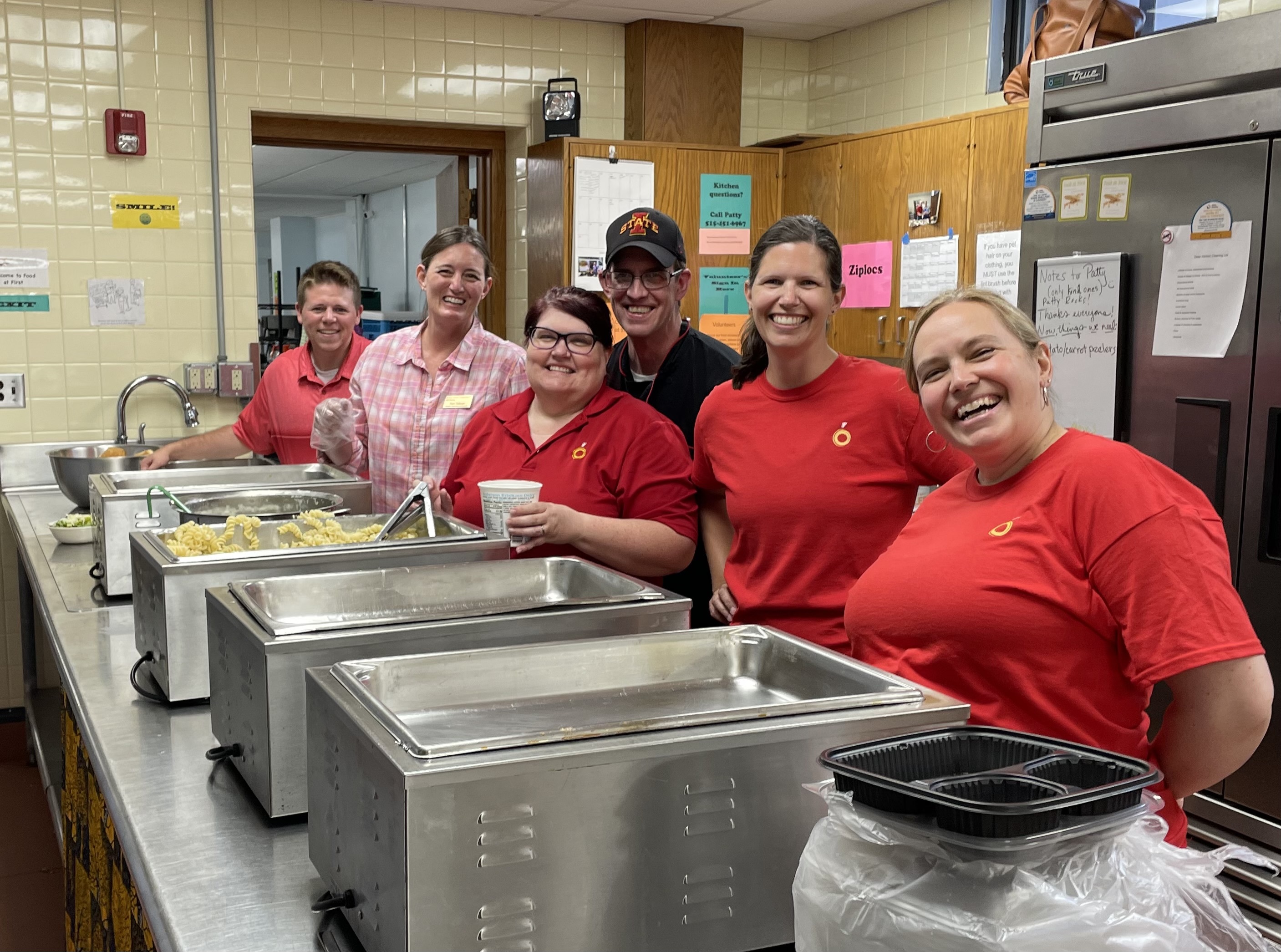
ISU Dining staff volunteering with Food at First, a nonprofit striving to address food insecurity in Ames. Contributed photo.
With more than 20 dining locations across campus plus catering for university events big and small, it's an understatement to say that ISU Dining prepares and serves a lot of food. But thanks to its sustainability efforts, it doesn't go to waste when dinner is done.
Composting
South of campus lies Iowa State's compost facility, constructed in 2008 to manage manure from the ISU Dairy Farm and compost organic waste materials. Though manure accounts for almost 80% of the facility's materials, the site began composting food waste from several dining units, including Seasons Marketplace, Conversations and the Union Drive Marketplace in 2009.
Approximately 300 tons -- around 600,000 pounds -- of food waste is diverted annually to create compost. The waste is pre- and post-consumer, and scraps left from prepping meals and uneaten food are transported to the facility to begin their second life as compost. Karen Rodekamp, associate director of engagement for ISU Dining, says the waste becomes compost within three to six months before being used around campus in construction and landscaping projects.
Giving back
Rodekamp is particularly proud of ISU Dining's decades-long partnership with Food at First, a local nonprofit that offers a daily free meal program and perishable food pantry to help address food insecurity in Ames.
Volunteers from Food at First come to campus dining locations several times a week to pick up day-old baked goods, unused meals from catered events and perishable items ahead of university holiday breaks that would otherwise be unusable when classes resumed. ISU Dining staff have also donated time and a helping hand to the nonprofit in the summer months when student volunteers are less available.
The Give a Swipe program is another way dining helps promote sustainability while supporting food security on campus. Students can donate Flex Meals or Dining Dollars during a scheduled donation period, and staff in the offices of student assistance, student wellness, financial aid, international students and scholars and student counseling services help identify students in need to receive these meals.
Buying local
A variety of ISU Dining's ingredients are purchased locally each year, ranging from fruits and vegetables to meat and more. Some of the produce comes from Iowa State's horticulture research station, located a few miles north of Ames on Highway 69. In addition to the positive impact on the local economy, buying local also reduces the use of fossil fuels needed to transport food to the university.
Rodekamp estimated that buying local products accounts for around 10% of the total food purchased by dining each year. In addition to products from Iowa State farms, dining works with Iowa producers and businesses like Dolan Farms, Old Capitol Food Co., Wells Blue Bunny and Cookies Food Products to source ingredients.
Rodekamp says dining strives to purchase locally whenever possible, though the growing season in Iowa can sometimes pose a challenge. "We basically have just six weeks from school starting in August to the first freeze of the fall," she said.
Luckily, campus partners like the horticulture research station have adapted to maximize the delivery window. Rodekamp credits superintendent Nick Howell and agricultural specialist Brandon Carpenter for creating a staggered planting and harvesting schedule for produce like bell peppers and onions – dining uses 5,000 pounds of each per year -- so dining can get fresh, local goods later in the season.
Recycling
Compost recycles food waste, but what about the boxes, jars and containers the food arrives in? Glass, plastic, cans, lightbulbs, old equipment, uniforms and lots of cardboard are among the many items ISU Dining recycles. Items that can be sold head to ISU Surplus, and not even used cooking oil goes to waste -- it's transformed into biodiesel fuel to power CyRide's buses.
Dining’s Bring Your Own Cup (BYOC) initiative encourages students and employees to grab their drink of choice in a reusable cup to save 35 cents and avoid wasting a disposable cup. BYOC is available at all campus cafes, and Rodekamp says approximately 6,000 cups were saved in the past year.
Prioritizing sustainability
Rodekamp says sustainability is a priority for ISU Dining not only because it's the right thing to do but because it's important to the students.
"Dining is part of the overall educational experience at Iowa State," Rodekamp said. "We employ more than 1,300 students a year in dining, and sustainability is important to our staff and student employees.
Rodekamp says it's special for students and dining staff to see the full circle process of something produced at Iowa State or locally served in the dining facilities and then recycled and composted to serve another purpose on campus. She emphasized that the sustainable efforts made by ISU Dining are possible because of partnerships on and off campus.
"We are very fortunate to have great relationships with the compost facility, horticulture research station, Food at First and so many other growers and producers," she said. "We could not be successful without these partners."
First phase of parking lot improvements begins Feb. 28
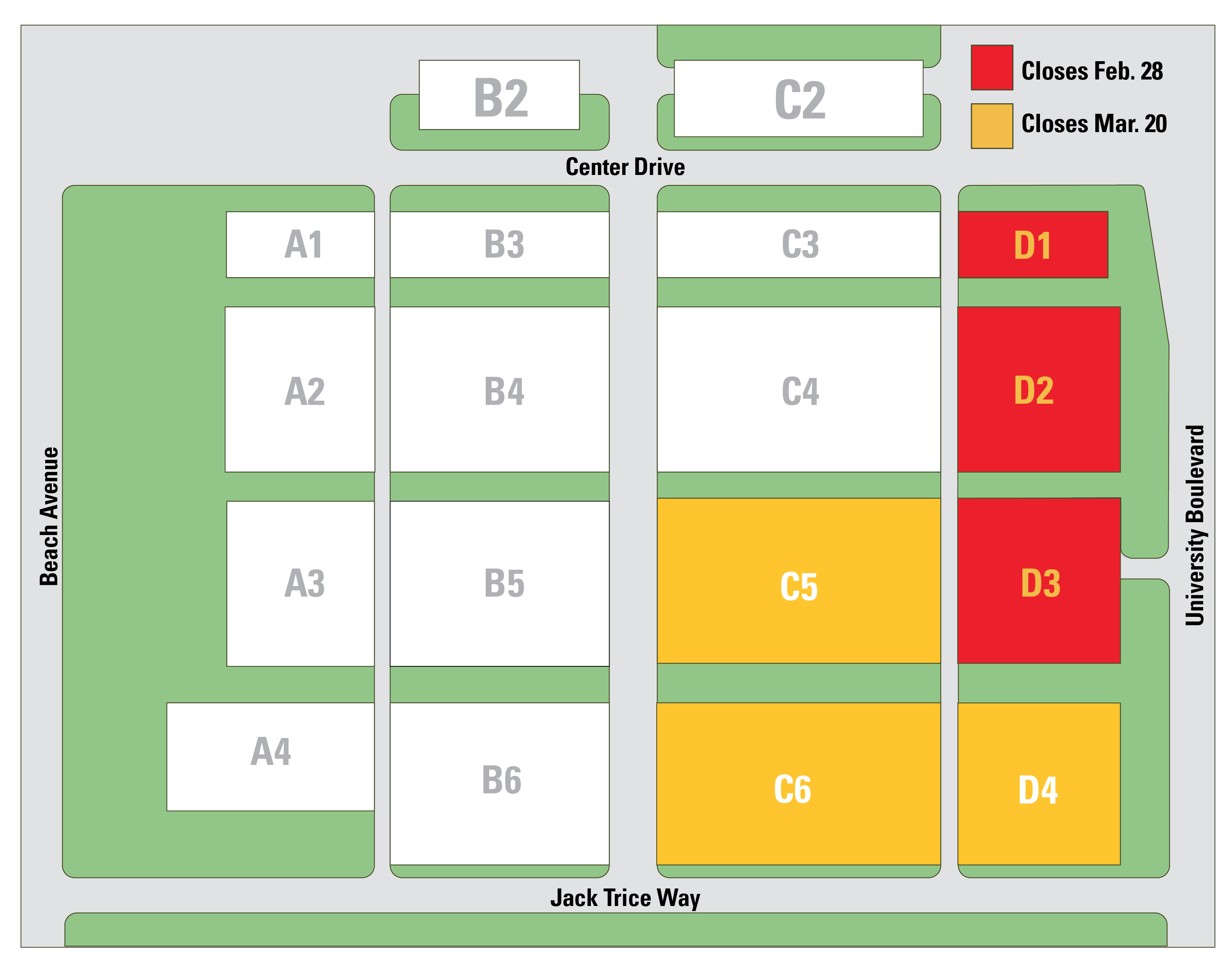
The C and D lots at the Iowa State Center will be upgraded this spring and summer, an early project to develop CYTown. Work on the A and B lots will occur in 2024. Graphic by Deb Berger.
Work on long-overdue improvements to the parking lots between Jack Trice Stadium and the Iowa State Center will begin Tuesday, Feb. 28, following the final home men's basketball game of the season.
Elder Construction, the firm selected for the first phase of CYTown, will start with the D lots on the east side along University Boulevard. Crews anticipate moving into lots C5 and C6 on the south end near Jack Trice Stadium (see map) on March 20. These lots will remain closed until mid-August.
Approximately 1,900 parking spots will remain available for student and employee commuters. Crews will wait until the end of spring semester to begin work on the remaining C lots (3 and 4).
The goal is to have the C and D lots finished by the start of fall semester and the 2023 football season. To meet this goal, construction crews expect to work seven days a week during daylight hours.
Chris Jorgensen, senior associate athletics director for operations, said the construction schedule is designed to limit impact on commuter parking and CyRide routes and provide ample parking for events.
The project includes installing utility infrastructure to support future CYTown development, new lighting and resurfacing the lots. Crews plan to grind the old asphalt on site and bring in fill dirt before resurfacing work begins. Work on the remaining Iowa State Center lots is expected to continue into 2024. Construction traffic will be routed off U.S. Hwy. 30, along University Boulevard to Jack Trice Way.
The athletics department will send additional information to donors who park in these lots during the football season.
Exploring student perceptions on sustainability
A recently published research project explores student perceptions about sustainability at Iowa State and how they felt curricular and extracurricular activities prepare them to approach sustainability challenges post-graduation. Students, faculty and staff affiliated with the Consortium for Cultivating Human And Naturally reGenerative Enterprises (C-CHANGE) completed the research last spring.
"One of the findings that jumped out right away is that students do feel that they are getting problem solving skills and feel empowered by their education and extracurricular experiences here at ISU," J. Arbuckle, sociology professor and C-CHANGE team member, said of the results. "However, many do not feel adequately prepared to engage with sustainability challenges post-graduation. They don't necessarily want more courses that are specifically about sustainability -- they want sustainability thinking to be integrated into most if not all of their courses."
The study also found that while students are interested in learning more about sustainability, they don't always pursue opportunities to get involved in activities and coursework related to it. Researchers cited three common barriers -- lack of awareness, courses and time -- and provided suggestions for improvement such as utilizing university communication channels to highlight sustainability coursework and events, integrating more sustainability themes into existing coursework and adding more sustainability-related courses overall.
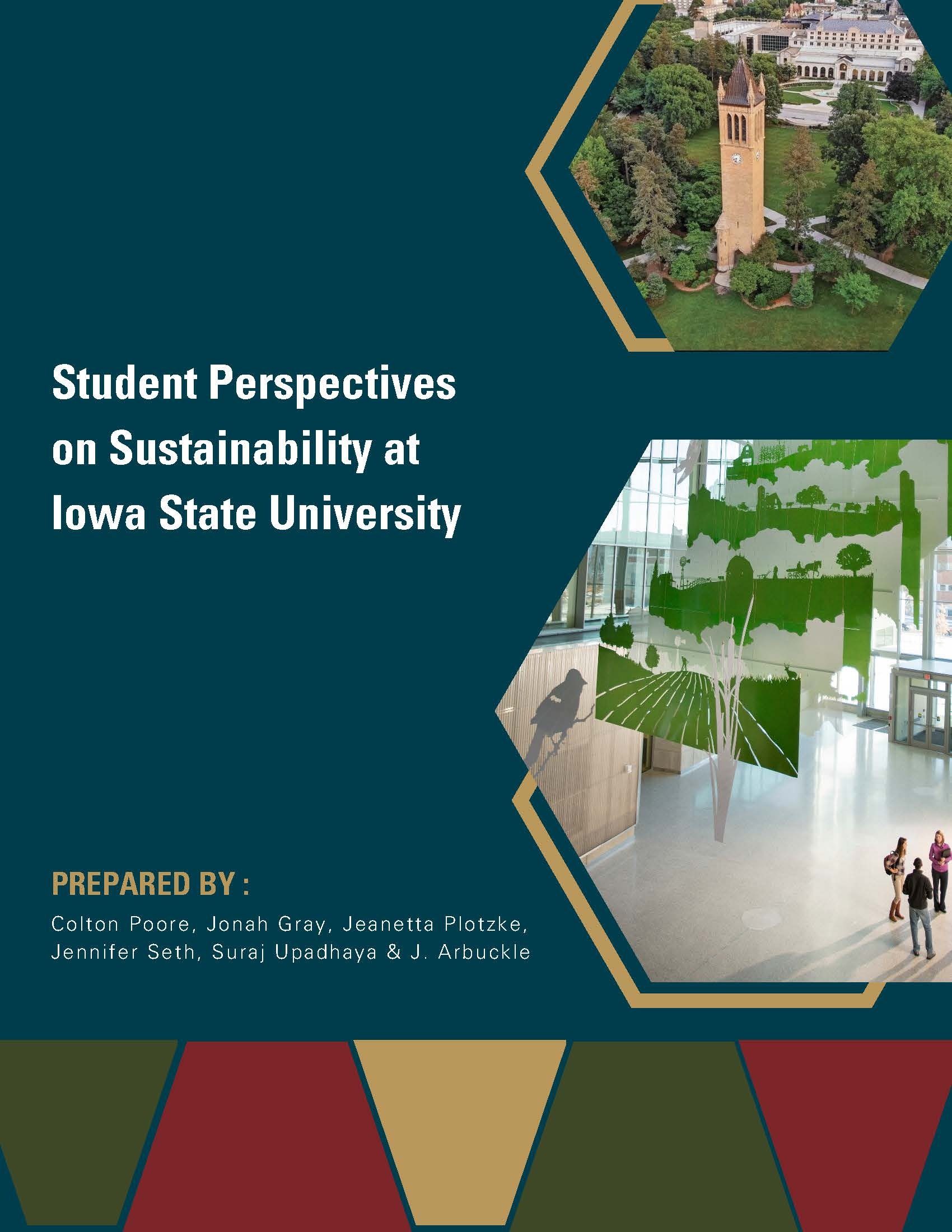
Read the report and learn more about C-CHANGE at cchange.research.iastate.edu.
Eighty-two percent of respondents also shared concern for the future if sustainability is not prioritized by society and more than 80% expressed that everyone, regardless of their field of study, should learn more about sustainability. Arbuckle said students in the focus groups echoed these sentiments and talked about the pressure of graduating into a world with increasingly serious sustainability challenges like climate change, water quality impairment and soil degradation. These students expressed that they want to be prepared in their discipline to be hirable candidates with skills to grapple with and respond to these issues.
"The number one takeaway is that Iowa State students want more engagement with sustainability both in their coursework and extracurriculars. They want sustainability thinking integrated across the board," Arbuckle emphasized. "Students recognize the sustainability challenges that we face as a country and as a world, and they want to be equipped to tackle them when they graduate and join the workforce."
Next steps
How can faculty and staff infuse more sustainability thinking into their work with students? Arbuckle says a good place to start is by identifying practical ways it can be incorporated into courses, disciplines and activities. "Everyone can find a creative way to integrate sustainability into their coursework, and the data from this research shows that many students would appreciate that," he said.
The report is the beginning of the dissemination process for this project. So far, it has been shared with leadership across campus and Jonah Gray, one of the students on the C-CHANGE team, presented a poster with the research at the Live Green program's Sustainapalooza on Feb. 21. Arbuckle said they plan to do more in-depth analysis of the data and are considering administering the survey every few years to gauge trends and progress at the university.
"From my perspective, the results are hopeful because it shows that students really care and want ISU to be a leader in sustainability," Arbuckle said. "As administrators, faculty and staff, we need to raise awareness of the sustainability-related research, education and outreach going on right now, as well as consider how to better incorporate sustainability thinking into more facets of the educational experience here at ISU."
The project
The research design and data collection effort were initiated in spring 2021 and administered between October 2021 and May 2022. The research team for Student Perspectives on Sustainability at Iowa State University used a mixed methods approach, collecting data through focus groups and a survey. They conducted five focus groups with undergraduate students from the colleges of Agriculture and Life Sciences, Engineering and Design who were involved in sustainability efforts on campus. Themes that arose from the focus groups helped the team design the survey, which it distributed to more than 15,000 juniors and seniors to understand their experiences with sustainability in their coursework and extracurricular activities at Iowa State.
C-CHANGE began in 2018 as a presidential interdisciplinary research initiative and expanded in 2020 to a multi-institutional consortium led by Iowa State with the goal of sparking interdisciplinary collaborations to address a variety of sustainability topics, especially those relating to agriculture.
On the rise: Student numbers in campus housing
Following pandemic years when the number of students living on campus dipped below 9,000, residence department leaders anticipate residence hall and apartment students will climb above 10,000 again in the next two years. The state Board of Regents received five-year residence plans, including proposed room and meal plan rates for next year, during its meeting Wednesday in Urbandale.
ISU's five-year plan projects occupancy gradually will increase from 9,946 students this fall (2023) to 10,391 in fall 2027. These projections include direct-from-high-school and transfer students who opt to live on campus and efforts to retain students already in campus housing. With the reopening of the second "Towers" building, Wilson Hall, as all single rooms to help meet demand, the department's capacity this fall rises to 10,319 beds.
The residence department proposes a 2.9% increase to most of its hall and apartment rates next year, no increases to its "dining dollar" packages, and a 5% increase to its 25- and 50-meal plans and academic year plans. On average, a room-meal package would go up 3.9%. For example, a nonair-conditioned double room with unlimited dining center meals would go up about $369, to $9,726.
The "door" price guests would pay in the campus dining centers also would go up about 5% as proposed, to $15 for lunch and dinner, to $11.65 for breakfast. The board will review housing and dining rate increase requests again at its April meeting.
Parking rates for next year
The regents received proposed campus parking increases this month, for final approval at the April meeting. Iowa State is proposing a 3% increase to campus parking permits and a 25-cent hourly increase (to $1.50) for metered stalls and lots for the fiscal year that begins July 1.
Proposed permit increases: ISU lots
|
Permit type |
Proposed FY24 |
Current |
|
24-hour reserved |
$1,076 |
$1,045 |
|
Reserved |
$623 |
$605 |
|
General staff* |
$199 |
$193 |
|
Departmental |
$233 |
$226 |
|
Vendor |
$348 |
$338 |
|
Motorcycle, employee |
$66 |
$64 |
|
Parking meters, metered lots |
$1.50/hour |
$1.25/hour |
*Includes residence and Ames Lab staffs
If approved, the parking division would increase the penalty for three parking violations by $5 each: overtime on parking meters (to $20), failure to purchase a parking receipt (to $20) and improper parking (to $30). The last violation excludes improperly using a space designated for people with disabilities, for which the fine remains $200.
Memorial Union staff manage the building's parking ramp. As proposed, permits generally would go up $20-$50. Hourly rates won't change next year at the MU ramp.
Proposed parking increases: Memorial Union ramp
|
Permit type |
Proposed FY24 |
Current |
|
Annual, MU employee |
$660 |
$610 |
|
Fall or spring |
$286 |
$266 |
|
Winter (Nov-Feb) |
$262 |
$260 |
|
Summer |
$237 |
$217 |
Efficiency in state government
Responding to Gov. Kim Reynolds' proposal to restructure state government, board president Michael Richards specifically addressed two resources currently under the regents' umbrella Reynolds would move to the state Department of Education: the Iowa Governor's STEM Advisory Council at the University of Northern Iowa and the Iowa School for the Deaf and Iowa Educational Services for the Blind and Visually Impaired, Council Bluffs, which serve a K-12 audience.
"UNI has done an amazing job building this capacity for the state of Iowa," Richards said of the council. He added he hopes the proposed change "would expand STEM programming for young people and communities."
On governance of the two specialty resources, Richards said "The DOE already oversees K-12 education statewide, including those with disabilities, and has the expertise and background to add oversight of the two," he said. "This alignment makes sense and will serve our students well."
ISU items
During the board's academic affairs committee meeting, chairman Jim Lindenmayer read a resolution thanking executive director of student financial aid Roberta Johnson for her decades of service to Iowa State and its students. Johnson will retire July 5.
"Thank you so much. It has been my honor and privilege," responded Johnson.
In other business, Iowa State received permission to:
- Begin planning for an estimated $10 million-$12 million in renovations to the lower two floors of the Iowa State Center's Scheman Building that would upgrade interior finishes, lighting and wayfinding in the entrance lobby, restrooms, event and circulation spaces. As proposed, the project also would upgrade food service areas and convert Benton auditorium to an open, flexible event space. The design process would include an evaluation of the center's exterior elevated walkway network. If repairs are required and funding permits, those would be a final piece of the project.
- Offer a bachelor of science degree in biomedical engineering starting this fall through the chemical and biological engineering department with collaboration from four others. It will have three emphasis areas: biomaterials, biomechanics and bioinstrumentation. Biomedical engineering is the sixth most popular engineering degree in the country, and its addition strengthens the College of Engineering, meets a high workforce demand (as demonstrated by 11 letters of support received from small and large companies) and offers another ISU pathway to medical school. Iowa State has offered a minor in biomedical engineering since 2009.
- Award honorary degrees at May commencement events. The first is a Doctor of Humane Letters to Trudy Huskamp Peterson, 1967 alumna and first woman archivist of the United States, for her advocacy for maintaining and preserving archives that involve human rights around the world and her commitment to sharing as much of the nation's heritage as possible. The second is a Doctor of Science to Temple Grandin, distinguished professor of animal sciences at Colorado State University, animal welfare pioneer and activist for people with autism, for an outstanding career in humane animal handling, animal welfare and related facilities design, and using her experience living with autism to influence her understanding of animal behavior.
- Reset its group of 10 peer institutions, used most frequently in reports to the board. Three of the current 10 remain: Michigan State, North Carolina State and Purdue universities. Seven universities were added, land-grants with Carnegie Research I classification whose missions and goals align more closely with Iowa State: Colorado State University, Fort Collins; Kansas State University, Manhattan; Oklahoma State University, Stillwater; Oregon State University, Corvallis; University of Missouri, Columbia; University of Nebraska, Lincoln; and Virginia Polytechnic and State University, Blacksburg.
- Close two centers: Plant Genomics Center and Plant Transformation Center, effective May 31. Remaining relevant research activity has been integrated into the Plant Sciences Institute.
Sustainability, wellness work together
ISU WellBeing staff look for ways to increase the success and happiness faculty and staff experience in their work. Senior WorkLife and WellBeing coordinator Stephanie Downs finds improving employees' lives often goes hand in hand with sustainability at the university -- and beyond.
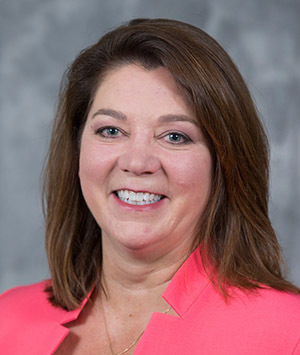
Stephanie Downs
"It shows up everywhere from stress management, social connection and decluttering and more," she said. "Realizing how you interact with others, connect with others, the environment you are working in, is critical to the well-being of everyone and everything involved. If we just stay focused on our physical health, we have missed the boat."
ISU WellBeing staff, in partnership with Live Green staff, will make sustainability the primary focus of the Adventure2 program this fall. Motivating people to be mindful of how everyday tasks and decisions impact them can lead to positive results, and individual efforts -- from recycling to the kind of chemicals you use on your lawn -- make a difference, Downs said.
Environmental sustainability
Iowa State is working toward becoming a health promoting university and college and aims to move beyond individual health to promoting a personal and organizational responsibility to the place people work and to the planet.
"We want to get people thinking about the food they eat, the water they drink and the air they breathe," Downs said. "Rethinking our connection to the earth often makes us slow down and think about the impact of our actions now and for future generations."
Recycling and being mindful of resources we use throughout the day can impact what reaches a landfill. How a lunch is packed -- a single-use plastic bag or reusable bag and the choice between plastic or reusable cutlery -- shows how an individual choice can make a difference and reduce our footprint.
ISU WellBeing has championed walking and getting out in nature to reconnect with people and the environment. Living through a pandemic showed the importance of interacting with others and how it helps when dealing with issues like anxiety and depression, Downs said. Strolls for Well-Being, walking meetings and Friday Walk and Talks have health benefits. ISU WellBeing also emphasizes the importance of ergonomics in the workplace to avoid issues. Sit/stand desks are more commonplace, and departments and units have the potential to be more efficient during remote work as employees share space.
Economic sustainability
Downs said the largest drivers of medical costs at ISU are musculoskeletal, cancer, behavioral health, and screenings and exams. Better health is a form of self-sustainability that can decrease health care costs and increase life expectancy.
"Taking care of our physical health is incredibly important, and doing those preventative things has a big impact as we age," she said. "The costs to us individually and as an institution can be quite substantial if we neglect it."
Iowa State has used a self-funded model for employee health and dental care and prescription drug service since 1996. Good health not only lowers medical costs, but increases quality of life as people age.
Finances also can be a stressor for many, but help is available through financial well-being services and resources at ISU. They help employees plan for retirement, set budgets and focus on spending for memories and experiences rather than things, reducing the strain on earth's resources.
ISU's insurance benefits offer Blue365 discounts to save employees money and assist with medical-related costs. Many vendors ISU partners with (TIAA, IPERS, etc.) provide virtual sessions for financial and retirement planning.
Social sustainability
ISU WellBeing focuses on numerous areas to help faculty and staff find fulfillment in their lives. Recently, mental health has been an emphasis.
"When you can declutter your mind and find some quiet, it helps you focus and improves the quality of life," Downs said.
The Employee Assistance Program offers free counseling, life coaching, financial and legal consultations, elder care and child resources. Caring for others is a daily occurrence for most people, but taking time for yourself also is important. Therapy Assistance Online can help develop life skills to find a better balance, and mindfulness activities also keep people connected and having a sense of community.
The pandemic reinforced how social humans are and the impact of a disruption to their social connections. Downs said a primary reason ISU WellBeing hosts events is to promote social interaction. Facilitating interactions among colleagues makes employees feel connected socially, physically and mentally. Making connections on campus often spreads into the community and leads to sustainable efforts on a larger scale, she added.
EU air freight reporting changes take effect March 1
On March 1, the European Union (EU) will implement phase 2 of its new Import Control System to collect information about all goods going in, or transitioning through any of its 27 member countries -- before it arrives. Air carriers and freight forwarders must submit information to EU Customs, where it is reviewed for possible security threats. Phase 2 specifically deals with cargo arriving by air.
To assist carriers in completing their Airway Bill form, university employees will need to provide more information about the items they're sending. With the exception of document shipments, all shipments, regardless of value, going to or transiting through the EU -- as well as Northern Ireland, Norway and Switzerland -- must have:
- A six-digit Harmonized System (HS) code, an international product classification system, also known as commodity or tariff codes. HS codes can be found in shipping applications and on a country's government website.
- For each item in the shipment, an accurate description that answers these questions: 1) What is it? 2) What is it made of? 3) What is it intended for? Where applicable, include the material composition breakdown (e.g., a dress made of 90% cotton and 10% polyester).
- Whenever possible, a recommended third piece of data is the Economic Operator Registration and Identification (EORI) number for the business or person you're sending the shipment to. Your shipping vendor must provide this number to European authorities.
These three items are recommended for all international shipments, even those not destined for the EU, due to the possibility of the shipment being routed through the EU territory.
Campus assistance
University staff in the office of research ethics (export controls) and postal and parcel services (PPS) are preparing for these changes in several ways.
- Export controls is updating its international shipment approval form to accommodate these requirements. Employees should electronically complete the International Shipping Procedures and Review form on the export controls website and discard any previously printed copies of this form. The EORI number is a static number that should be requested from the intended recipient when you obtain the delivery address.
- As needed, PPS staff will assist with determining six-digit HS codes. To do this, each item description must be complete. Employees who know the correct HS code are asked to include it with the item description. Shipments lacking the information needed to determine HS code(s) will be delayed leaving campus until the employee or unit provides these details.
Electronic upgrade saves reams of paper, reaps award
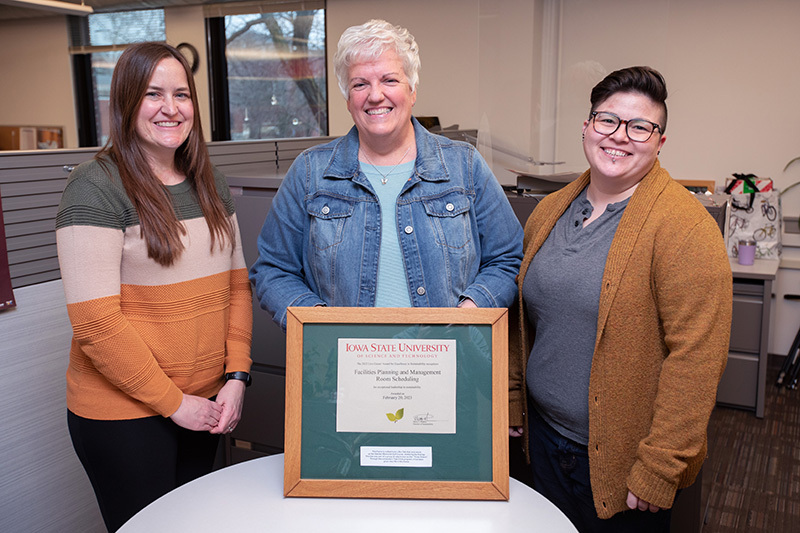
The room scheduling team (l-r) of scheduling coordinator Elizabeth Salton, room scheduling specialist Katie Baumgarn and scheduling coordinator Alesha Magee won a Live Green! Award for Excellence in Sustainability in the operations category. Photo by Christopher Gannon.
Scheduling a classroom used to leave quite the paper trail.
The stacks of paper got so high that room scheduling specialist Katie Baumgarn and her team decided there had to be a better way. It led to a digital revolution in the office that swept away piles of paper and earned Baumgarn and scheduling coordinators Alesha Magee and Elizabeth Salton a Live Green! Award for Excellence in Sustainability in the operations category.
Nearly 15 years ago, the room scheduling team began receiving electronic requests, but with it a hard copy automatically printed to assist a team member with data entry. Requests for more than 200 general university classrooms, and requests from student organizations and departments needing space for meetings, tutoring and exams used reams of paper. On top of that, hackers occasionally would get into the system and make copious amounts of fake requests, leading to additional wasted paper.
With the help of facilities planning and management's (FPM) technology services staff, the entire process now is electronic, saving paper for more than a decade and making the entire process more efficient.
"It has improved the efficiency of all the offices that deal with this because we no longer have to go through piles of paper looking for what we need," Baumgarn said. "With the old process, it was easily three to four reams of paper per semester."
To further cut down on paper use, the same team digitized the course offering change form, eliminating a process that featured triplicate copies shared across campus. Preliminary lists of room assignments -- ranging from one to 30 pages -- used to be sent out for review at the start of each semester before departments made changes and photocopied the pages. The move to an electronic format eliminated the excessive paper use.
These efforts also inspired the office of the registrar to migrate some of its paper reports to electronic format, something Baumgarn hopes other departments and units may consider.
Recycling also has been important to the room scheduling team members, which dutifully used the backs of all those discarded printed pages for scratch paper and were among the first in FPM to remove trash baskets from their workstations.
